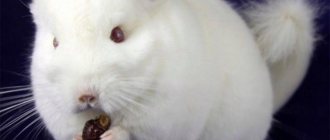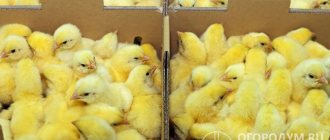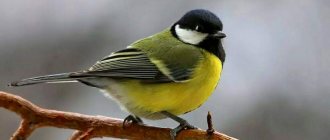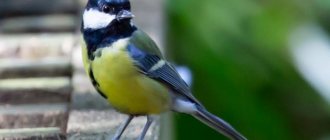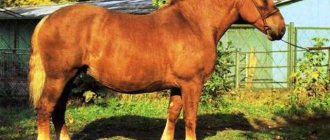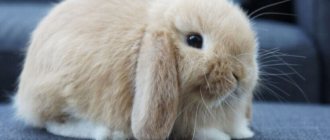What does a capybara look like?
Capybaras have a square muzzle and wide-set miniature ears that they often flap. The animal has 20 teeth; the tail is practically absent.
Capybaras are very massive animals: their body resembles a barrel, and their weight reaches 60 kilograms. The capybara's front legs are shorter than its hind legs, so it looks like it's about to sit on its hips like a dog.
On the ground, this rodent either gallops or shuffles; Capybaras feel more confident in water, since they have small membranes on their limbs. They have three toes on their hind feet and four on their front feet.
Perhaps the most accurate description of this animal was given by the British naturalist Gerald Durrell, according to whom the capybara has a very aristocratic appearance, reminiscent of a brooding lion.
Note!
- Euthanasia of animals.
- Spitz. Features of the breed.
Car hammock for dogs. What it is?
Take a look at the photo of the capybara’s face: you will agree, there is something majestic about it
Conditions for keeping
There are many requirements for the living conditions of a rodent. The capybara is a pet that needs space, and it is also good for him to be able to go outside. There it is worth equipping a small yard for the animal so that it can eat herbaceous plants and also sharpen its teeth. Tree branches can be used for this purpose.
The rodent also needs freedom in the water so that it can freely plunge, dive and simply swim. For this purpose, they usually equip a small pool for the capybara, where it can frolic and feel as comfortable and free as possible.
Important! If you are not going to breed rodents, then the male should be castrated, otherwise during puberty he may begin to pester the owner.
Of course, the preferred place of residence for rodents is a private home, since there they will have enough space to maintain activity. If you live in an apartment, then you will need to take the animal for walks, after attaching a leash to it.
Capybara character
Capybaras are noticeably different from other rodents: they are almost never in a hurry, they are difficult to anger, and they are also a little lazy. Not even a little: these animals never build holes and sleep right on the ground.
By the way, capybaras sleep a little: they like to eat after sleep, so they often wake up and go in search of food.
Features of the diet
Capybaras are herbivores. The basis of the diet of rodents is plants, which contain predominantly protein structures.
- Detailed description with photos of all animals included in the Red Book of Russia
- Zebra - habitats, appearance, diet and behavior, life cycle + 94 photos
Leopard - habitats, life cycle, rutting season and lifespan + 118 photos
At home, you can also feed your pet algae. Additionally, they need to be given special food for rodents, multivitamin complexes, which contain all the substances necessary for the animal’s body.
Where and how long do capybaras live?
Capybaras primarily live in the tropical forests of South America, as well as Panama. They prefer to live in small groups of 10-20 individuals on an area of 1 hectare.
In the wild, capybaras live for about 10 years, in captivity - about 12. They reach sexual maturity at 2 years, and almost every year females give birth to 2 to 8 cubs.
Note!
- Removal and cremation of animals
Cynologists - who are they?
Car soundproofing. What is she like?
Small capybaras are miniature copies of their parents; they are sighted from birth and quickly become accustomed to plant foods.
Mara
The animal lives on the rocky plateaus of Argentina and Patagonia and looks slightly like a kangaroo. Mara is a distant relative of the well-known domestic guinea pig and belongs to the half-ungulate family. An adult rodent weighs about 20 kilograms, and its body length often reaches 50 centimeters.
In Patagonia, locals call the maru the lowland hare, since the rodent's hind legs are much longer than its front ones and help it jump long distances. In addition, the habits of the mara are similar to those of a hare. When an animal runs away from a predator, it jumps in a zigzag pattern, straining all 4 legs at the same time.
Capybaras and other animals
Capybara is an Internet star. She hugged everyone in the photographs: kittens, ducklings, and even managed to lie in the sun with a crocodile! Take a look at the photos of the animals: the capybara is not at all afraid of one of its natural enemies!
However, it is not only crocodiles that hunt the capybara. In water, rodents are hunted by caimans, and on land by anacondas and jaguars. However, capybaras hide from land enemies in the water, keeping only their nostrils on the surface.
Reproduction
The mating period is not limited by seasons; they make love in water at any time of the year. But preference is still given to the rainy season, when there is plenty of water and food. The cavaliers leave their marks on the plants, which the female uses to find them. During the breeding season, one female can have several males.
Pregnancy lasts 150 days, and birth takes place on land. A newborn baby weighs “only” 1.5 kg, he is quite independent and can immediately begin to feast on grass and fruits. An adult is considered to be one who has reached the age of 17–18 months.
The female usually gives birth to two to six babies, which she feeds with milk for up to 16 weeks. The maternal instinct is so strong that they do not distinguish between “us” and “strangers”, becoming excellent adoptive mothers.
Interesting facts about the capybara
- The very name of the animal comes from one of the dead Indian languages and means “eater of fine herbs”;
- The capybara is also called the capybara, since in appearance it resembles a huge guinea pig;
- This rodent does not have undercoat, so to protect itself from the sun, the capybara bathes in mud;
- Capybaras can bark and often make clicking sounds;
- Unlike other rodents, the capybara does not know how to eat, holding food with its front paws;
- In South America they loved capybara meat so much that at one time they designated it as meatless, recognizing the rodent as a fish;
- The Japanese love capybaras so much that they even created comics about them! True, in them she looks more like a hamster.
Kinds
In the last century, the capybara formed its own family group in the biological classifier. Now it is classified as a member of the pig family (Caviidae). This makes it similar to guinea pigs, animals called kui, mara, moko and other large rodents that are similar in appearance. Capybaras form an independent group, which bears the generic name “capybaras” or Hydrochoerus. The capybara genus includes two living species:
- Capybara is the nominate species. Its scientific name is Hydrochoerus hydrochaeris. Other names in common use: common capybara, large capybara .
- Small copybara. This animal was recognized as an independent species in 1980. Previously, it was believed that Hydrochoerus isthmius, as it is called in the scientific world, is a subspecies of the common capybara.
The genus of capybaras, confirming their ancient origin, includes a species that became extinct millions of years ago - Hydrochoerus gaylordi. In 1991, the remains of this animal were found in Grenada. The prehistoric capybara lived in the late Cenozoic. This conclusion was made by a group of American paleontologists who discovered, described and systematized the find.
Belgian giant
And now to domestic rodents. Two rabbits of this breed live in the UK, and their owners staged a competition to see which one could grow the biggest. It is a mistake to classify rabbits as rodents, because they belong to the order Lagomorpha. But people often refer to them as rodents. It is not for nothing that Carl Linnaeus initially identified rabbits and rodents as a single class of rodents.
Ralph the rabbit, with a weight of 22 kilograms, is the heaviest on the planet, but Darius made it into the book of records because of his body length, which is 1.3 meters.
Perhaps Darius will be overtaken by his own son, nicknamed Jeff. Which has already reached a length of 1 meter, and by the age of maturity the length of the rabbit can increase significantly.
And there is a very interesting article on thebiggest about the largest breeds of rabbits.
4
Cute pet
Despite its impressive appearance, the capybara is a very friendly animal. A complacent, submissive expression froze on his muzzle, his eyes were meek, his character was calm.
You can also read:
The largest lizard
Recently, exotic lovers have been happy to keep a giant capybara at home. This phlegmatic person is absolutely safe, he will not bite or scratch. He cuddles up to his owners like a faithful dog; he is even walked on a leash, like a dog.
Maintenance does not cause problems, since the capybara does not shed, is very clean, and even eats its own feces. The main thing is to provide her with a swimming pool and a walking area.
The animals' brains are the size of a lemon, so they are quite smart animals and can be trained. They can give their owner a paw or sit on command.
These large rodents are not yet found in Russia.
Price
Seeing such a cute pet, many people wonder how much an unusual rodent can cost? A walk with such a pet will attract everyone's attention. In addition, communication with a kind lout lifts your mood - scientists have long proven that having pets helps to resist stress and illness. Surprisingly, sometimes you come across an advertisement that excess animals are given away for free. But this is rare. In general, a giant pig can cost from 50 to 150 thousand rubles. depending on the region.
For Russia this is still very rare. In addition, it requires special conditions of detention - a swimming pool, a heated winter enclosure (after all, the animals are accustomed to a tropical climate).
